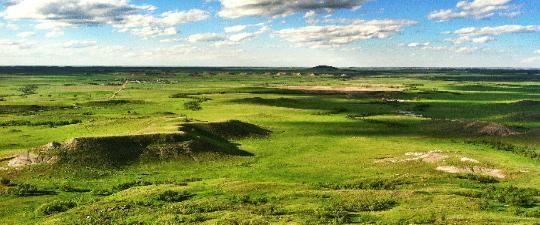Founded 19 September 1912 Population 1,823 (2013) | Congressional district At-large Area 2,595 km² Unemployment rate 2.5% (Apr 2015) | |
 | ||
Website www.goldenvalleycounty.org Rivers Bullion Creek, Beaver Creek, Little Beaver Creek | ||
Golden Valley County is a county located in the U.S. state of North Dakota. As of the 2010 census, the population was 1,680, making it the fourth-least populous county in North Dakota. The county seat is Beach. The county was organized on November 13, 1912.
Contents
- Map of Golden Valley County ND USA
- History
- Election controversy
- Geography
- Adjacent counties
- Major highways
- National protected area
- 2000 census
- 2010 census
- Cities
- Unincorporated communities
- Former townships
- Unorganized territories
- Notable people
- References
Map of Golden Valley County, ND, USA
The county should not be confused with the city of Golden Valley, which is located in Mercer County.
History
Golden Valley was originally part of Billings County. Voters elected to separate from Billings County in 1910, but litigation prevented formal organization of the county until 1912. The territory in the surrounding area was colloquially referred to as, Rattlesnake Flats, due to the large number of the snakes found in the area. The region was dubbed Golden Valley in 1902 after a group of land surveyors noticed that the sunlight gave the surrounding grasses a distinct golden color.
Election controversy
The vote in 1910 to create Golden Valley County was 837 for and 756 against. Shortly after the vote was certified, suit was filed against the Billings County Commission to overturn the result. The plaintiffs alleged that the certification of election was improper, and that certain pre-marked "unofficial" ballots printed by supporters of the new county were cast in place of official ballots, and should be voided. The trial court originally ruled in favor of the plaintiffs. The county appealed to the North Dakota Supreme Court, which upheld the county's certification of the election. The court also ruled the pre-marked ballots were invalid, but that the number of invalid votes was not sufficient to overturn the election results. The court's decision upholding the new county was made on September 19, 1912, and Golden Valley was formally organized on November 13, 1912.
Geography
According to the U.S. Census Bureau, the county has a total area of 1,002 square miles (2,600 km2), of which 1,001 square miles (2,590 km2) is land and 1.6 square miles (4.1 km2) (0.2%) is water.
Adjacent counties
Major highways
National protected area
2000 census
As of the census of 2000, there were 1,924 people, 761 households, and 506 families residing in the county. The population density was 1.92 people per square mile (0.74/km²). There were 973 housing units at an average density of 0.97 per square mile (0.37/km²). The racial makeup of the county was 97.77% White, 0.73% Native American, 0.10% Asian, 0.31% from other races, and 1.09% from two or more races. 1.04% of the population is Hispanic or Latino of any race. 49.4% were of German, 13.7% Norwegian and 5.6% Polish ancestry.
There were 761 households out of which 29.20% had children under the age of 18 living with them, 58.30% were married couples living together, 4.90% had a female householder with no husband present, and 33.40% were non-families. 31.50% of all households were made up of individuals and 15.80% had someone living alone who was 65 years of age or older. The average household size was 2.38 and the average family size was 3.01.
In the county, the population was spread out with 28.30% under the age of 18, 5.10% from 18 to 24, 22.20% from 25 to 44, 23.00% from 45 to 64, and 21.30% who were 65 years of age or older. The median age was 41 years. For every 100 females there were 92.60 males. For every 100 females age 18 and over, there were 88.10 males.
The median income for a household in the county was $29,967, and the median income for a family was $37,105. Males had a median income of $25,478 versus $18,000 for females. The per capita income for the county was $14,173. About 10.80% of families and 15.30% of the population were below the poverty line, including 21.40% of those under age 18 and 7.70% of those age 65 or over.
2010 census
As of the 2010 United States Census, there were 1,680 people, 774 households, and 429 families residing in the county. The population density was 1.7 inhabitants per square mile (0.66/km2). There were 967 housing units at an average density of 1.0 per square mile (0.39/km2). The racial makeup of the county was 97.4% white, 0.6% American Indian, 0.6% black or African American, 0.1% Pacific islander, 0.1% Asian, 0.5% from other races, and 0.8% from two or more races. Those of Hispanic or Latino origin made up 2.1% of the population. In terms of ancestry, 69.0% were German, 14.7% were Norwegian, 10.7% were Polish, 7.9% were Irish, 7.5% were English, and 2.5% were American.
Of the 774 households, 22.7% had children under the age of 18 living with them, 48.4% were married couples living together, 4.3% had a female householder with no husband present, 44.6% were non-families, and 39.4% of all households were made up of individuals. The average household size was 2.10 and the average family size was 2.85. The median age was 45.9 years.
The median income for a household in the county was $33,333 and the median income for a family was $47,500. Males had a median income of $32,875 versus $26,750 for females. The per capita income for the county was $21,899. About 8.9% of families and 13.0% of the population were below the poverty line, including 17.7% of those under age 18 and 11.4% of those age 65 or over.
